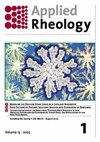A simulation-based approach to evaluate objective material parameters from concrete rheometer measurements
IF 1.8
4区 工程技术
Q1 MECHANICS
引用次数: 5
Abstract
Abstract Modern concretes such as ultra-high performance concrete (UHPC) show excellent strength properties combined with favorable flow properties. However, the flow properties depend strongly on process parameters during production (temperature, humidity etc.), but also change sensitively even with slight variations in the mixture. In order to ensure desired processing of the fluidlike material and consistent process quality, the flow properties of the concrete must be evaluated quantitatively and objectively. The usual evaluation of measurements from concrete rheometers, for example of the ball probe system type, does not allow the direct determination of the objective material parameters yield stress and plastic viscosity of the sample. We developed a simulation-based method for the evaluation of rheometric measurements of fine grained high performance concretes like self-compacting concrete (SCC) and UHPC. The method is based on a dimensional analysis for ball measuring systems. Through numerical parameter studies we were able to describe the identified relationship between measuring quantities and material parameters quantitatively for two devices of this type. The evaluation method is based on the Bingham model. With this method it is possible to measure both the yield stress and the plastic viscosity of the fresh sample simultaneously. Device independence of the evaluation process is proven and an application to fiber-reinforced UHPC is presented.从混凝土流变仪测量中评估客观材料参数的一种基于模拟的方法
超高性能混凝土(UHPC)等现代混凝土具有优异的强度性能和良好的流动性能。然而,流动特性在很大程度上取决于生产过程中的工艺参数(温度、湿度等),但即使在混合物中有轻微的变化,也会发生敏感的变化。为了保证流体状材料的理想加工和一致的加工质量,必须对混凝土的流动特性进行定量和客观的评价。通常对混凝土流变仪的测量结果进行评估,例如球探头系统类型,不允许直接确定样品的客观材料参数、屈服应力和塑性粘度。我们开发了一种基于模拟的方法来评估细粒高性能混凝土(如自密实混凝土(SCC)和UHPC)的流变测量。该方法是基于量纲分析的球测量系统。通过数值参数研究,我们能够定量地描述这两种装置的测量量与材料参数之间确定的关系。评价方法基于Bingham模型。用这种方法可以同时测量新鲜样品的屈服应力和塑性粘度。验证了评估过程的设备独立性,并提出了在纤维增强UHPC中的应用。
本文章由计算机程序翻译,如有差异,请以英文原文为准。
求助全文
约1分钟内获得全文
求助全文
来源期刊

Applied Rheology
物理-力学
CiteScore
3.00
自引率
5.60%
发文量
7
审稿时长
>12 weeks
期刊介绍:
Applied Rheology is a peer-reviewed, open access, electronic journal devoted to the publication in the field of applied rheology. The journal provides the readers with free, instant, and permanent access to all content worldwide; and the authors with extensive promotion of published articles, long-time preservation, language-correction services, no space constraints and immediate publication.
 求助内容:
求助内容: 应助结果提醒方式:
应助结果提醒方式:


